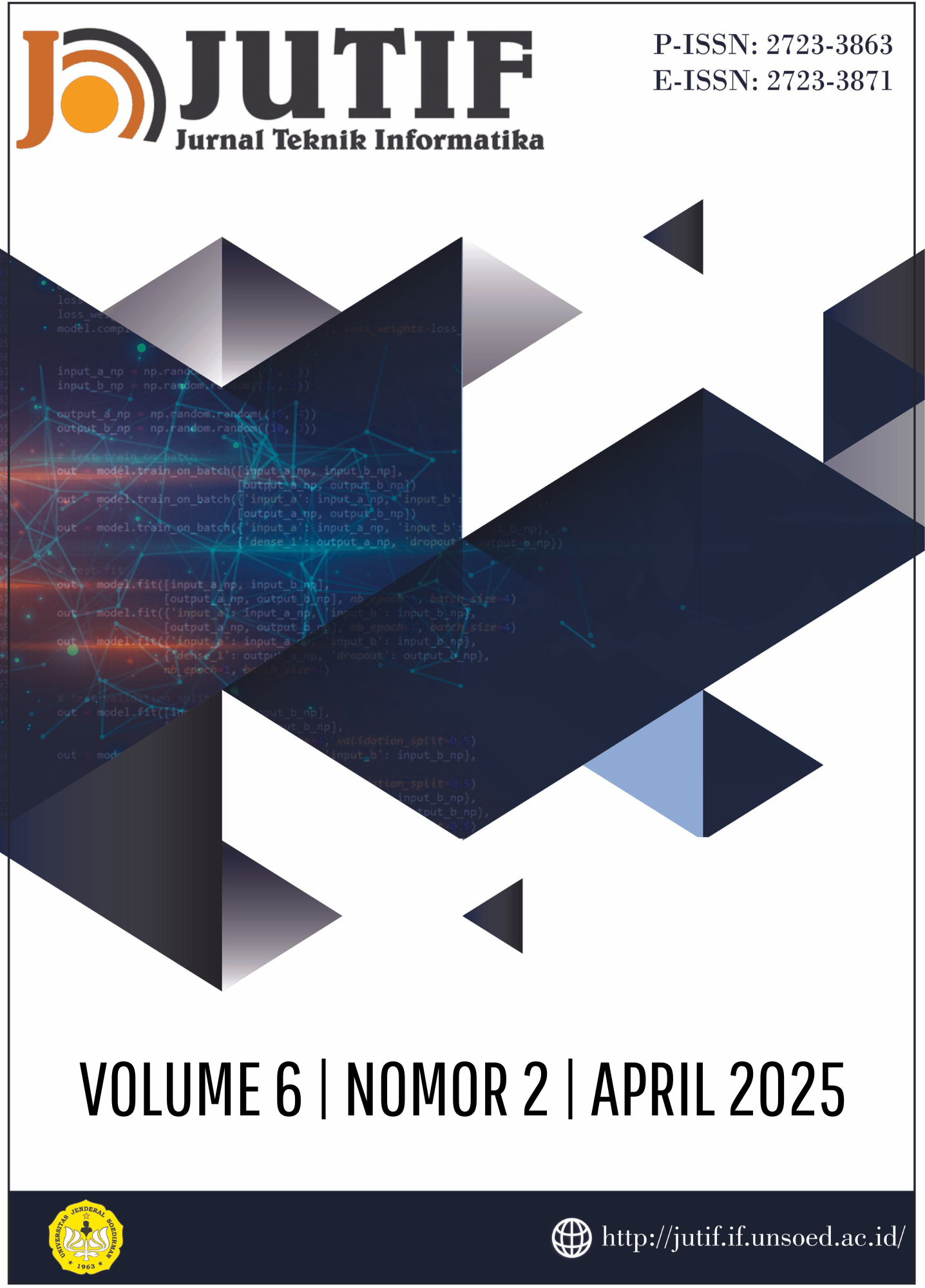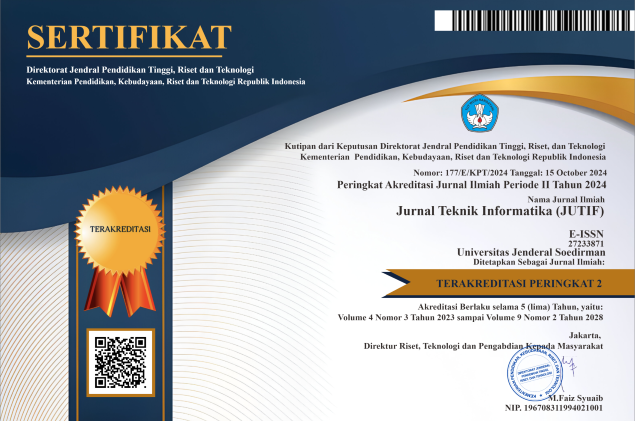Analyzing Public Sentiment on the Relocation of Indonesia's Capital to Kalimantan as the Ibu Kota Nusantara Using Logistic Regression
DOI:
https://doi.org/10.52436/1.jutif.2025.6.2.4230Keywords:
IKN Sentiment, Logistic Regression, N-gram, Preprocessing, Public Opinion, TF-IDFAbstract
The Ibu Kota Nusantara (IKN) relocation project aims to equalize economic development and reduce the burden on Jakarta, but has elicited mixed reactions from the public, including both support and opposition. Therefore, this study applies machine learning-based sentiment analysis, using Logistic Regression to explore public opinion on the relocation, and leveraging social media data from platform X to gain insights into information, opinions, and public reactions. The Textblob, VADER, and SentiWordNet labeling methods employ a majority vote of the three labels to determine the final label. In order to achieve data balance, SMOTE is employed in this study. Moreover, this study applies a combination of preprocessing, N-gram, and TF-IDF to illuminate the impact of this combination on model performance. The results indicate that the combination of preprocessing Scenario 3 with unigram, bigram, trigram, and TF-IDF feature extraction yields the best performance, achieving a precision of 0.7641, recall of 0.7767, F1-score of 0.7634, and accuracy of 0.7641. This research demonstrates the efficacy of proper preprocessing and feature extraction in enhancing the performance of the Logistic Regression model for sentiment classification, thereby contributing to the analysis of public opinion on IKN policy regarding other issues in the future.
Downloads
References
D. A. Permatasari and . S., “New National Capital City (IKN) in Legal Polemic,” KnE Social Sciences, pp. 862–871, Jan. 2024, doi: 10.18502/kss.v8i21.14801.
T. Baharuddin, A. Nurmandi, Z. Qodir, H. Jubba, and M. Syamsurrijal, “Bibliometric Analysis of Socio-Political Research on Capital Relocation: Examining Contributions to the Case of Indonesia,” Journal of Local Government Issues, vol. 5, no. 1, pp. 17–31, Mar. 2022, doi: 10.22219/logos.v5i1.19468.
R. Bonita and D. Wadley, “Disposal of government offices in Jakarta pending relocation of the Indonesian capital: an application of multi-criteria analysis,” Property Management, vol. 40, no. 4, pp. 591–628, Jul. 2022, doi: 10.1108/PM-10-2020-0068.
A. Hadinata and B. M Cynthia, “The state capital relocation policy and pandemic covid-19: a literature review,” Journal of Economics and Business Letters, vol. 1, pp. 24–27, 2021, doi: 10.32479/ijefi.11348.
M. Nurdin and T. Baharuddin, “Capacity Building Challenges and Strategies in the Development of New Capital City of Indonesia,” Jurnal Bina Praja, vol. 15, no. 2, pp. 221– 232, Aug. 2023, doi: 10.21787/jbp.15.2023.221-232.
W. Nurharjadmo, F. Ansoriyah, and M. A. Khadija, “Analyzing Public Perception using Aspect Based Sentiment Analysis: Case Study of Capital Relocation Planning of Indonesia,” in 2024 7th International Conference on Informatics and Computational Sciences (ICICoS), 2024, pp. 191–196. doi: 10.1109/ICICoS62600.2024.10636903.
T. Xie, Y. yao Wei, W. fan Chen, and H. nan Huang, “Parallel evolution and response decision method for public sentiment based on system dynamics,” Eur J Oper Res, vol. 287, no. 3, pp. 1131–1148, Dec. 2020, doi: 10.1016/j.ejor.2020.05.025.
N. Helberger, “The Political Power of Platforms: How Current Attempts to Regulate Misinformation Amplify Opinion Power,” Digital Journalism, vol. 8, no. 6, pp. 842–854, Jul. 2020, doi: 10.1080/21670811.2020.1773888.
H. Ihsaniyati, S. Sarwoprasodjo, P. Muljono, and D. Gandasari, “The Use of Social Media for Development Communication and Social Change: A Review,” Feb. 01, 2023, MDPI. doi: 10.3390/su15032283.
A. Sesagiri Raamkumar, M. Erdt, H. Vijayakumar, E. Rasmussen, and Y.-L. Theng, “Understanding the Twitter Usage of Humanities and Social Sciences Academic Journals,” Proceedings of the Association for Information Science and Technology, vol. 55, pp. 430–439, 2018, doi: 10.1002/pra2.2018.14505501047.
A. Kumar and A. Jaiswal, “Systematic literature review of sentiment analysis on Twitter using soft computing techniques,” Concurr Comput, vol. 32, p. e5107, Nov. 2019, doi: 10.1002/cpe.5107.
G. Karuna, P. Anvesh, C. S. Singh, K. R. Reddy, P. K. Shah, and S. S. Shankar, “Feasible Sentiment Analysis of Real Time Twitter Data,” in E3S Web of Conferences, Oct. 2023, p. 10. doi: 10.1051/e3sconf/202343001045.
R. J. Medford, S. N. Saleh, A. Sumarsono, T. M. Perl, and C. U. Lehmann, “An ‘Infodemic’: Leveraging high-volume twitter data to understand early public sentiment for the Coronavirus disease 2019 outbreak,” Open Forum Infect Dis, vol. 7, no. 7, Jul. 2020, doi: 10.1093/ofid/ofaa258.
M. P. Abraham, “Feature Based Sentiment Analysis of Mobile Product Reviews using Machine Learning Techniques,” International Journal of Advanced Trends in Computer Science and Engineering, vol. 9, no. 2, pp. 2289–2296, 2020, doi: 10.30534/ijatcse/2020/210922020.
S. Sonare and M. Kamble, “Sentiment Analysis in polished Product Based Inspections data using existing supervised machine learning approach,” in 2021 IEEE International Conference on Technology, Research, and Innovation for Betterment of Society, TRIBES 2021, 2021, pp. 1–6. doi: 10.1109/TRIBES52498.2021.9751663.
F. Huang, X. Li, C. Yuan, S. Zhang, J. Zhang, and S. Qiao, “Attention-Emotion-Enhanced Convolutional LSTM for Sentiment Analysis,” IEEE Trans Neural Netw Learn Syst, vol. 33, no. 9, pp. 4332–4345, 2022, doi: 10.1109/TNNLS.2021.3056664.
F. Fazrin, O. N. Pratiwi, and R. Andreswati, “Perbandingan Algoritma K-Nearest Neighbor dan Logistic Regression pada Analisis Sentimen terhadap Vaksinasi Covid-19 pada Media Sosial Twitter dengan Pelabelan Vader Dan Textblob,” eProceedings of Engineering, vol. 10, no. 2,
p. 1596, Apr. 2023.
P. Harjule, A. Gurjar, H. Seth, and P. Thakur, “Text Classification on Twitter Data,” in 2020 3rd International Conference on Emerging Technologies in Computer Engineering: Machine Learning and Internet of Things (ICETCE), 2020, pp. 160–164. doi: 10.1109/ICETCE48199.2020.9091774.
O. Shobayo, S. Adeyemi-Longe, O. Popoola, and B. Ogunleye, “Innovative Sentiment Analysis and Prediction of Stock Price Using FinBERT, GPT-4 and Logistic Regression: A Data-Driven Approach,” Big Data and Cognitive Computing, vol. 8, no. 11, Nov. 2024, doi: 10.3390/bdcc8110143.
R. Ahuja, A. Chug, S. Kohli, S. Gupta, and P. Ahuja, “The impact of features extraction on the sentiment analysis,” Procedia Comput Sci, vol. 152, pp. 341–348, 2019, doi: 10.1016/j.procs.2019.05.008.
H. R. Alhakiem and E. B. Setiawan, “Aspect-Based Sentiment Analysis on Twitter Using Logistic Regression with FastText Feature Expansion,” Jurnal RESTI (Rekayasa Sistem dan Teknologi Informasi), vol. 6, no. 5, pp. 840–846, 2022, doi: 10.29207/resti.v6i5.4429.
D. Jurafsky and J. H. Martin, Speech and Language Processing. 2024.
A. Poormina and S. P. K, “A Comparative Sentiment Analysis Of Sentence Embedding Using Machine Learning Techniques,” 2020 6th International Conference on Advanced Computing & Communication Systems (ICACCS) , pp. 493–496, 2020, doi: 10.1109/ICACCS48705.2020.9074312.
M. I. Ramadhon, A. Arini, F. Mintarsih, and I. M. M. Matin, “N-Gram and K-Nearest Neighbor Algorithm for Sentiment Analysis on Capital Relocation,” in 2021 9th International Conference on Cyber and IT Service Management, CITSM 2021, IEEE, 2021. doi: 10.1109/CITSM52892.2021.9587919.
E. Sutoyo and A. Almaarif, “Twitter sentiment analysis of the relocation of Indonesia’s capital city,” Bulletin of Electrical Engineering and Informatics, vol. 9, no. 4, pp. 1620–1630, Aug. 2020, doi: 10.11591/eei.v9i4.2352.
A. Sinha, B. Rout, S. Mohanty, S. R. Mishra, H. Mohapatra, and S. Dey, “Exploring Sentiments in the Russia-Ukraine Conflict: A Comparative Analysis of KNN, Decision Tree and Logistic Regression Machine Learning Classifiers,” in Procedia Computer Science, Elsevier B.V., 2024, pp. 1068–1076. doi: 10.1016/j.procs.2024.04.101.
T. Wahyuningsih, D. Manongga, I. Sembiring, and S. Wijono, “Comparison of Effectiveness of Logistic Regression, Naive Bayes, and Random Forest Algorithms in Predicting Student Arguments,” in Procedia Computer Science, Elsevier B.V., 2024, pp. 349–356. doi: 10.1016/j.procs.2024.03.014.
Y. Qi and Z. Shabrina, “Sentiment analysis using Twitter data: a comparative application of lexicon- and machine-learning-based approach,” Soc Netw Anal Min, vol. 13, no. 1, Dec. 2023, doi: 10.1007/s13278-023-01030-x.
S. Bengesi, T. Oladunni, R. Olusegun, and H. Audu, “A Machine Learning-Sentiment Analysis on Monkeypox Outbreak: An Extensive Dataset to Show the Polarity of Public Opinion From Twitter Tweets,” IEEE Access, vol. 11, pp. 11811–11826, 2023, doi: 10.1109/ACCESS.2023.3242290.
N. M. Sham and A. Mohamed, “Climate Change Sentiment Analysis Using Lexicon, Machine Learning and Hybrid Approaches,” Sustainability (Switzerland), vol. 14, no. 8, p. 4723, Apr. 2022, doi: 10.3390/su14084723.
V. Da Poian et al., “Exploratory data analysis (EDA) machine learning approaches for ocean world analog mass spectrometry,” Frontiers in Astronomy and Space Sciences, vol. 10, May 2023, doi: 10.3389/fspas.2023.1134141.
S. Sumayah, F. Sembiring, and W. Jatmiko, “ANALYSIS OF SENTIMENT OF INDONESIAN COMMUNITY ON METAVERSE USING SUPPORT VECTOR MACHINE
ALGORITHM,” Jurnal Teknik Informatika (Jutif), vol. 4, no. 1, pp. 143–150, 2023, doi: 10.52436/1.jutif.2023.4.1.417.
H. T. Duong and T. A. Nguyen-Thi, “A review: preprocessing techniques and data augmentation for sentiment analysis,” Comput Soc Netw, vol. 8, no. 1, Dec. 2021, doi: 10.1186/s40649-020-00080-x.
A. Larasati, R. P. Editya, Y. W. Chen, and V. E. B. Darmawan, “The Effect of Data Splitting Ratio and Vectorizer Method on the Accuracy of the Support Vector Machine and Naïve Bayes Model to Perform Sentiment Analysis,” in ICEEIE 2023 - International Conference on Electrical, Electronics and Information Engineering, Institute of Electrical and Electronics Engineers Inc., 2023, p. 1. doi: 10.1109/ICEEIE59078.2023.10334755.
K. U. Wijaya and E. B. Setiawan, “Hate Speech Detection Using Convolutional Neural Network and Gated Recurrent Unit with FastText Feature Expansion on Twitter,” Jurnal Ilmiah Teknik Elektro Komputer dan Informatika (JITEKI), vol. 9, no. 3, pp. 619–631, Sep. 2023, doi: 10.26555/jiteki.v9i3.26532.
C. C. Wang, M. Y. Day, and C. L. Wu, “Political Hate Speech Detection and Lexicon Building: A Study in Taiwan,” IEEE Access, vol. 10, pp. 44337–44346, 2022, doi: 10.1109/ACCESS.2022.3160712.
S. Fahmi, L. Purnamawati, G. F. Shidik, M. Muljono, and A. Z. Fanani, “Sentiment analysis of student review in learning management system based on sastrawi stemmer and SVM-PSO,” in Proceedings - 2020 International Seminar on Application for Technology of Information and Communication: IT Challenges for Sustainability, Scalability, and Security in the Age of Digital Disruption, iSemantic 2020, IEEE, 2020, pp. 643–648. doi: 10.1109/iSemantic50169.2020.9234291.
G. A. Dalaorao, A. M. Sison, and R. P. Medina, “Integrating Collocation as TF-IDF Enhancement to Improve Classification Accuracy,” in TSSA 2019 - 13th International Conference on Telecommunication Systems, Services, and Applications, Proceedings, 2019, pp. 282–85. doi: 10.1109/TSSA48701.2019.8985458.
H. Aljuaid, R. Iftikhar, S. Ahmad, M. Asif, and M. Tanvir Afzal, “Important citation identification using sentiment analysis of in-text citations,” Telematics and Informatics, vol. 56, 2021, doi: 10.1016/j.tele.2020.101492.
U. Bhattacharjee, P. K. Srijith, and M. S. Desarkar, “Term Specific TF-IDF Boosting for Detection of Rumours in Social Networks,” in 2019 11th International Conference on Communication Systems and Networks, COMSNETS 2019, IEEE, 2019. doi: 10.1109/COMSNETS.2019.8711427.
M. Umer et al., “Scientific papers citation analysis using textual features and SMOTE resampling techniques,” Pattern Recognit Lett, vol. 150, pp. 250–257, Oct. 2021, doi: 10.1016/j.patrec.2021.07.009.
M. Z. Ali, Ehsan-Ul-Haq, S. Rauf, K. Javed, and S. Hussain, “Improving Hate Speech Detection of Urdu Tweets Using Sentiment Analysis,” IEEE Access, vol. 9, pp. 84296–84305, 2021, doi: 10.1109/ACCESS.2021.3087827.
H. Hairani, T. Widiyaningtyas, and D. Prasetya, “Addressing Class Imbalance of Health Data: A Systematic Literature Review on Modified Synthetic Minority Oversampling Technique (SMOTE) Strategies,” JOIV International Journal on Informatics Visualization, vol. 8, pp. 1310–1318, Dec. 2024, doi: 10.62527/joiv.8.3.2283.
S. Yang and G. Berdine, “Confusion matrix,” The Southwest Respiratory and Critical Care Chronicles, vol. 12, no. 53, pp. 75–79, Oct. 2024, doi: 10.12746/swrccc.v12i53.1391.
F. A. Ramadhan and P. H. Gunawan, “Sentiment Analysis of 2024 Presidential Candidates in Indonesia: Statistical Descriptive and Logistic Regression Approach,” 2023 International Conference on Data Science and Its Applications, ICoDSA 2023, pp. 327–332, 2023, doi: 10.1109/ICODSA58501.2023.10276417.
M. Işik and H. Dağ, “The impact of text preprocessing on the prediction of review ratings,” 2020, Turkiye Klinikleri. doi: 10.3906/elk-1907-46.
N. Dankolo et al., “Systematic Review on Text Normalization Techniques and its Approach to Non-Standard Words,” Int J Comput Appl, vol. 185, no. 33, pp. 975–8887, Sep. 2023.
A. W. Andi, C. Slamet, D. S. Maylawati, J. Jumadi, A. R. Atmadja, and M. A. Ramdhani, “Sentiment Analysis of State Capital Relocation of Indonesia using Convolutional Neural Network,” in 2022 IEEE 8th International Conference on Computing, Engineering and Design (ICCED), 2022, pp. 1–6. doi: 10.1109/ICCED56140.2022.10010503.
J. Muliawan and E. Dazki, “SENTIMENT ANALYSIS OF INDONESIA’S CAPITAL CITY RELOCATION USING THREE ALGORITHMS: NAÏVE BAYES, KNN, AND RANDOM
FOREST,” Jurnal Teknik Informatika (JUTIF), vol. 4, no. 5, pp. 1227–1236, 2023, doi: 10.52436/1.jutif.2023.4.5.347.
K. S. S. Varma, P. Sathineni, and R. Mamidi, “Sentiment Analysis in Code-Mixed Telugu- English Text with Unsupervised Data Normalization,” in International Conference Recent Advances in Natural Language Processing, RANLP, Incoma Ltd, 2021, pp. 753–760. doi: 10.26615/978-954-452-072-4_086.
S. K. Johal and R. Mohana, “Effectiveness of Normalization Over Processing of Textual Data Using Hybrid Approach Sentiment Analysis,” Int. J. Grid High Perform. Comput., vol. 12, pp. 43–56, 2020, doi: 10.4018/ijghpc.2020070103.
A. S. Safitri, I. Wijayanto, and S. Hadiyoso, “Improving Classification Accuracy With Preprocessing Techniques For Sentiment Analysis,” 2024 International Conference on Data Science and Its Applications (ICoDSA), pp. 487–490, 2024, doi: 10.1109/ICoDSA62899.2024.10651657.
P. Vrnssvsaileela, N. Naga, M. Rao, and A. Budati, “Iterative Ensemble Learning over High Dimensional Data for Sentiment Analysis,” Scalable Comput. Pract. Exp., vol. 25, pp. 1219– 1234, 2024, doi: 10.12694/scpe.v25i2.2650.
T. Trueman, A. K. Jayaraman, and E. Cambria, “An N-gram-Based BERT model for Sentiment Classification Using Movie Reviews,” 2022 International Conference on Artificial Intelligence and Data Engineering (AIDE), pp. 41–46, 2022, doi: 10.1109/AIDE57180.2022.10060044.
A. Zakaria and M. Siallagan, “Predicting Customer Satisfaction through Sentiment Analysis on Online Review,” International Journal of Current Science Research and Review, p., 2023, doi: 10.47191/ijcsrr/v6-i1-56.
F. Resyanto, Y. Sibaroni, and A. Romadhony, “Choosing The Most Optimum Text Preprocessing Method for Sentiment Analysis: Case:iPhone Tweets,” in 2019 Fourth International Conference on Informatics and Computing (ICIC), 2019, pp. 1–5. doi: 10.1109/ICIC47613.2019.8985943.
S. Pradha, M. N. Halgamuge, and N. Tran Quoc Vinh, “Effective Text Data Preprocessing Technique for Sentiment Analysis in Social Media Data,” in 2019 11th International Conference on Knowledge and Systems Engineering (KSE), 2019, pp. 1–8. doi: 10.1109/KSE.2019.8919368.
Additional Files
Published
How to Cite
Issue
Section
License
Copyright (c) 2025 Warih Maharani, Agisni Zahra

This work is licensed under a Creative Commons Attribution 4.0 International License.



























